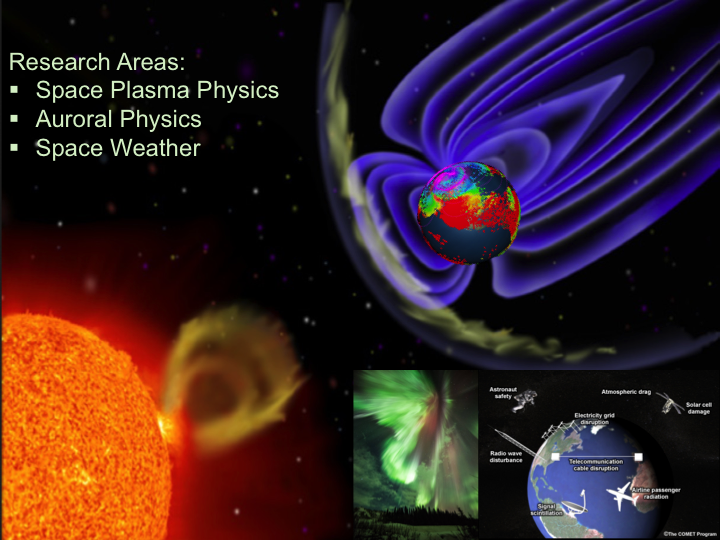Overview
The Sun’s extended atmosphere, i.e., solar wind, and the Earth’s magnetic field interact, giving rise to an integrated system in the near-Earth space driven by the transfer of mass, momentum, and energy from the Sun. This complex system is characterized by coupling and feedback as well as preconditioning and memory.
I study interactions between the solar wind, magnetosphere and ionosphere, in particular, space-weather disturbances (e.g., storm, substorm, dynamic pressure variations), global plasma circulation, and large-scale current systems, using a combination of data analysis and numerical simulation.
My work spans several critical areas of space science, including but not limited to:
- Ionospheric and Thermospheric Physics: Investigating the dynamics and behavior of the ionosphere and thermosphere. This research explores their responses to solar and geomagnetic activities, the formation and evolution of plasma structures, and the mechanisms of energy transfer within these regions.
- Magnetosphere-Ionosphere Coupling: Understanding the coupling processes between the magnetosphere and the ionosphere during space weather events such as geomagnetic storms and substorms. My research investigates the exchange of energy and particles between these regions and how it affects ionospheric currents, plasma density distributions, and atmospheric heating.
- Numerical Modeling and Simulations: Utilizing sophisticated numerical models and simulations to study space physics phenomena. These tools are integral to simulating conditions and processes in the ionosphere and thermosphere, offering insights that complement observational data.
- Data Analysis and Integration: Conducting extensive data analysis from a variety of sources, including satellites, ground-based observations, and other measurement instruments. Integrating these datasets enables validation of models and provides a comprehensive understanding of the studied phenomena.
- Impact on Communication and Navigation Systems: Investigating how space weather influences technological systems on Earth, particularly those relying on ionospheric properties such as communication and navigation systems.
What’s Happening in the Group?
- I am looking for talented, creative, and highly motivated postdocs and graduate students to join the group. Please contact me if you are interested.
- Aug. 21, 2024: Congratulations to Grace! Her NASA Heliophysics FINESST proposal has been selected. The proposal title is “The impact of storm-time ionospheric density structures on ion upflow flux“.
- Aug. 2023: Congratulations to Yulu as a winner of the 2023 MIPSE Graduate Fellowship!
- Aug. 2023: Congratulations to Grace as a winner of the 2022 Rackham Merit Fellowship!
- Aug. 23, 2022: Congratulations to Alanah! Her NASA Heliophysics FINESST proposal has been selected. The proposal title is “SEA-EPB: A Statistical and Event Analysis of Super Equatorial Plasma Bubbles”.
- Jun. 28, 2021: Congratulations to Alanah as a winner of the 2021 CEDAR workshop undergraduate poster Honorable Mention award! Her presentation title is “Statistical and event analysis of phase and amplitude scintillations associated with polar cap patches”.
- Mar. 24, 2021: Congratulations to Alanah as a winner of the 2021 Rackham Merit Fellowship!
- Mar. 20, 2021: Congratulations to Alanah as a winner of the 2021 Michigan Institute for Computational Discovery & Engineering (MICDE) Fellowship!
- Mar. 06, 2020: Congratulations to Zihan as a winner of the 2020 Richard and Eleanor Towner Prize for Distinguished Academic Achievement.
- Feb. 26, 2020: Congratulations to Zihan as a winner of the 2019 AGU Outstanding Paper Award! The presentation title is “Segmentation of Storm-Enhanced Density by Boundary Flows Associated with Westward Drifting Partial Ring current”.

